YAMAHA GRIZZLY 350 2017 Owners Manual
Manufacturer: YAMAHA, Model Year: 2017, Model line: GRIZZLY 350, Model: YAMAHA GRIZZLY 350 2017Pages: 140, PDF Size: 3.23 MB
Page 101 of 140
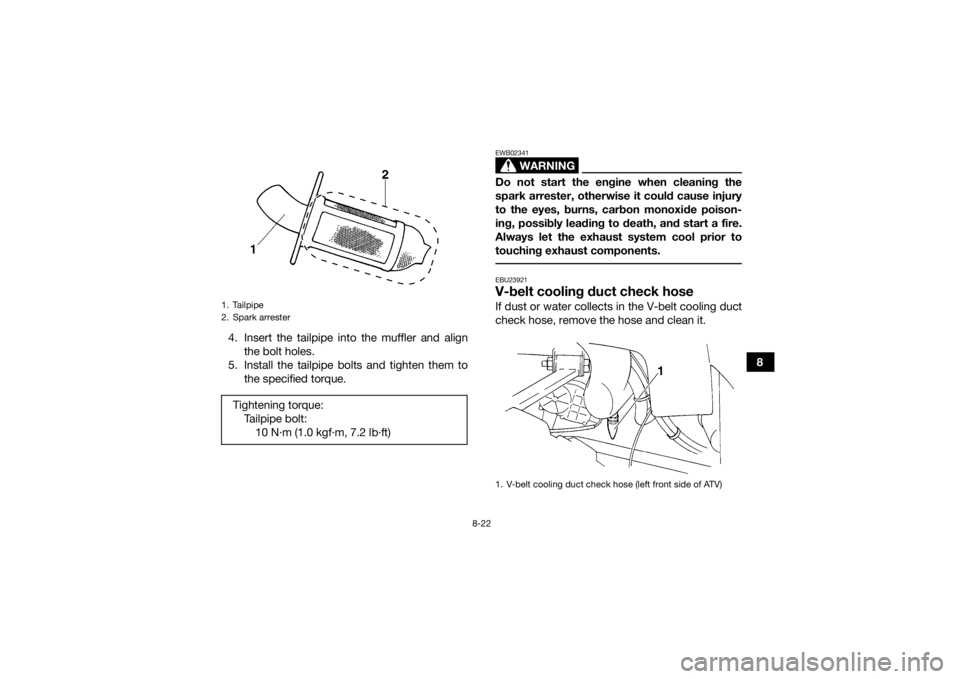
8-22
8
4. Insert the tailpipe into the muffler and align
the bolt holes.
5. Install the tailpipe bolts and tighten them to the specified torque.
WARNING
EWB02341Do not start the engine when cleaning the
spark arrester, otherwise it could cause injury
to the eyes, burns, carbon monoxide poison-
ing, possibly leading to death, and start a fire.
Always let the exhaust system cool prior to
touching exhaust components. EBU23921V-belt cooling duct check hoseIf dust or water collects in the V-belt cooling duct
check hose, remove the hose and clean it.
1. Tailpipe
2. Spark arresterTightening torque:Tailpipe bolt:10 N·m (1.0 kgf·m, 7.2 lb·ft)
1. V-belt cooling duct check hose (left front side of ATV)
UB1463E0.book Page 22 Thursday, August 4, 2016 2:12 PM
Page 102 of 140
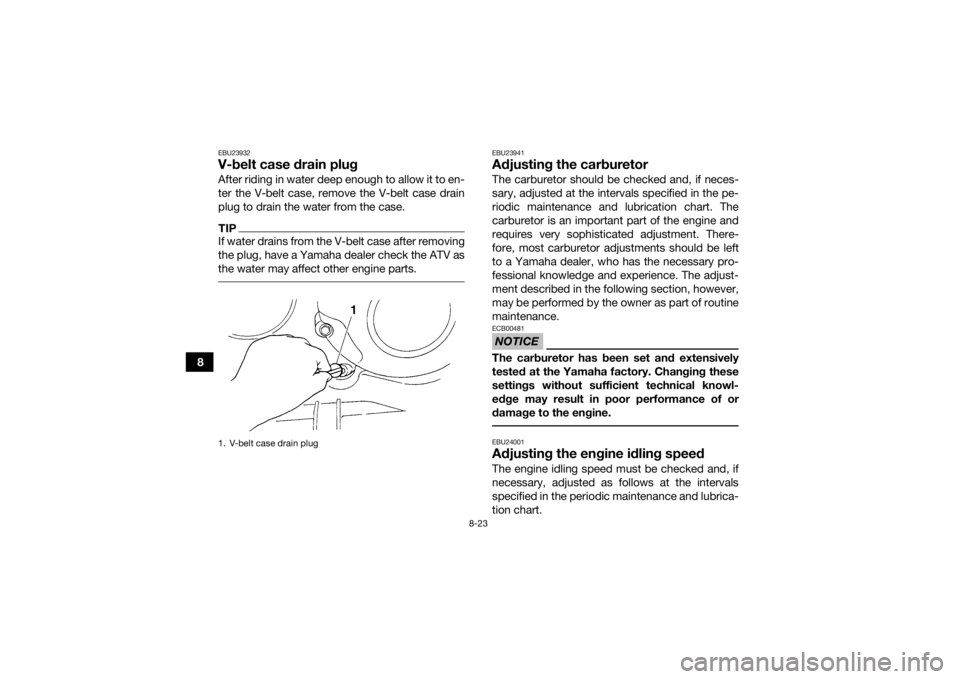
8-23
8
EBU23932V-belt case drain plugAfter riding in water deep enough to allow it to en-
ter the V-belt case, remove the V-belt case drain
plug to drain the water from the case.TIPIf water drains from the V-belt case after removing
the plug, have a Yamaha dealer check the ATV as
the water may affect other engine parts.
EBU23941Adjusting the carburetorThe carburetor should be checked and, if neces-
sary, adjusted at the intervals specified in the pe-
riodic maintenance and lubrication chart. The
carburetor is an important part of the engine and
requires very sophisticated adjustment. There-
fore, most carburetor adjustments should be left
to a Yamaha dealer, who has the necessary pro-
fessional knowledge and experience. The adjust-
ment described in the following section, however,
may be performed by the owner as part of routine
maintenance.NOTICEECB00481The carburetor has been set and extensively
tested at the Yamaha factory. Changing these
settings without sufficient technical knowl-
edge may result in poor performance of or
damage to the engine. EBU24001Adjusting the engine idling speedThe engine idling speed must be checked and, if
necessary, adjusted as follows at the intervals
specified in the periodic maintenance and lubrica-
tion chart.
1. V-belt case drain plugUB1463E0.book Page 23 Thursday, August 4, 2016 2:12 PM
Page 103 of 140
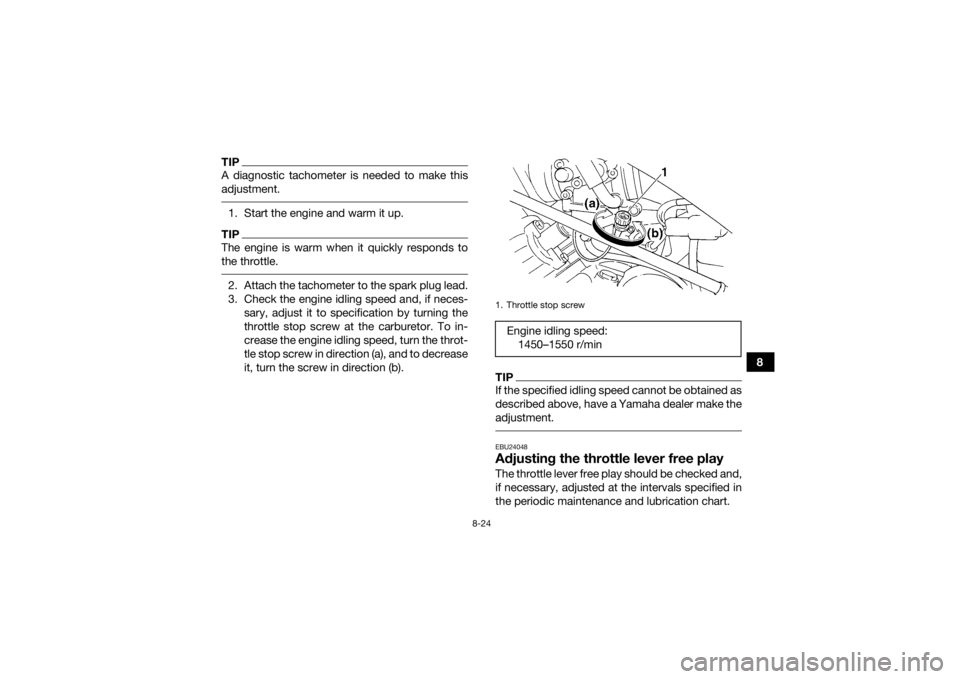
8-24
8
TIPA diagnostic tachometer is needed to make this
adjustment. 1. Start the engine and warm it up.TIPThe engine is warm when it quickly responds to
the throttle. 2. Attach the tachometer to the spark plug lead.
3. Check the engine idling speed and, if neces-sary, adjust it to specification by turning the
throttle stop screw at the carburetor. To in-
crease the engine idling speed, turn the throt-
tle stop screw in direction (a), and to decrease
it, turn the screw in direction (b).
TIPIf the specified idling speed cannot be obtained as
described above, have a Yamaha dealer make the
adjustment. EBU24048Adjusting the throttle lever free playThe throttle lever free play should be checked and,
if necessary, adjusted at the intervals specified in
the periodic maintenance and lubrication chart.1. Throttle stop screwEngine idling speed:1450–1550 r/min
UB1463E0.book Page 24 Thursday, August 4, 2016 2:12 PM
Page 104 of 140
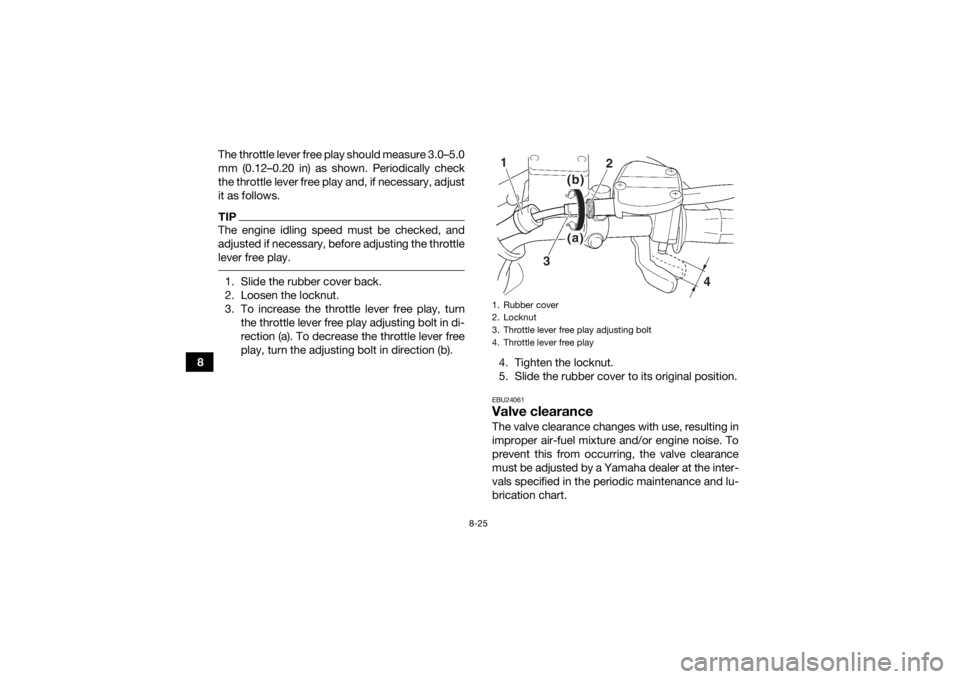
8-25
8The throttle lever free play should measure 3.0–5.0
mm (0.12–0.20 in) as shown. Periodically check
the throttle lever free play and, if necessary, adjust
it as follows.
TIPThe engine idling speed must be checked, and
adjusted if necessary, before adjusting the throttle
lever free play. 1. Slide the rubber cover back.
2. Loosen the locknut.
3. To increase the throttle lever free play, turn
the throttle lever free play adjusting bolt in di-
rection (a). To decrease the throttle lever free
play, turn the adjusting bolt in direction (b). 4. Tighten the locknut.
5. Slide the rubber cover to its original position.
EBU24061Valve clearanceThe valve clearance changes with use, resulting in
improper air-fuel mixture and/or engine noise. To
prevent this from occurring, the valve clearance
must be adjusted by a Yamaha dealer at the inter-
vals specified in the periodic maintenance and lu-
brication chart.1. Rubber cover
2. Locknut
3. Throttle lever free play adjusting bolt
4. Throttle lever free play12
3 4
UB1463E0.book Page 25 Thursday, August 4, 2016 2:12 PM
Page 105 of 140
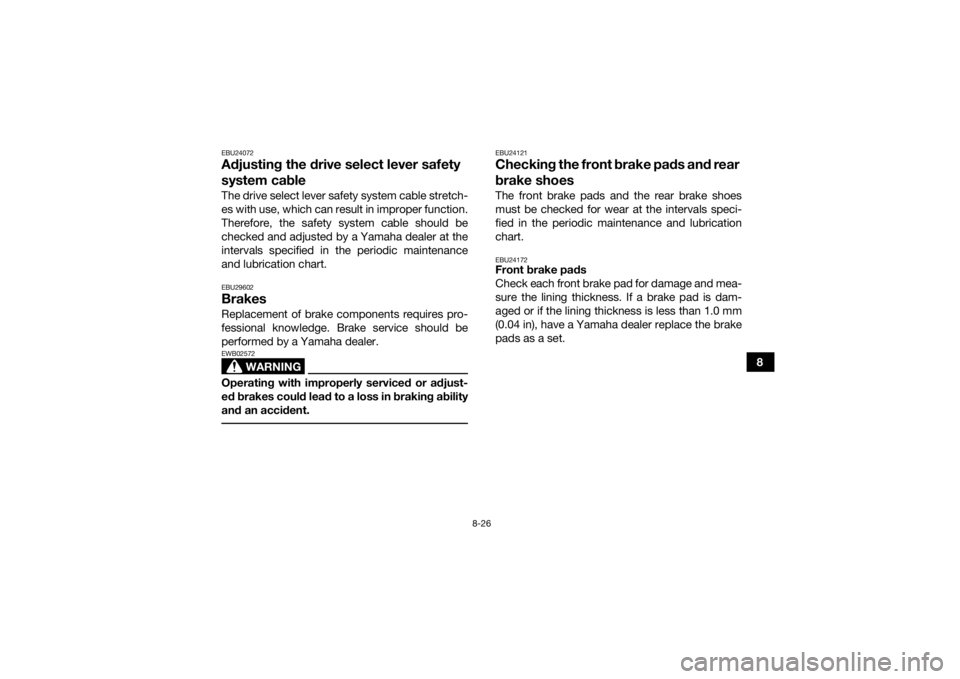
8-26
8
EBU24072Adjusting the drive select lever safety
system cableThe drive select lever safety system cable stretch-
es with use, which can result in improper function.
Therefore, the safety system cable should be
checked and adjusted by a Yamaha dealer at the
intervals specified in the periodic maintenance
and lubrication chart.EBU29602BrakesReplacement of brake components requires pro-
fessional knowledge. Brake service should be
performed by a Yamaha dealer.
WARNING
EWB02572Operating with improperly serviced or adjust-
ed brakes could lead to a loss in braking ability
and an accident.
EBU24121Checking the front brake pads and rear
brake shoesThe front brake pads and the rear brake shoes
must be checked for wear at the intervals speci-
fied in the periodic maintenance and lubrication
chart.EBU24172Front brake pads
Check each front brake pad for damage and mea-
sure the lining thickness. If a brake pad is dam-
aged or if the lining thickness is less than 1.0 mm
(0.04 in), have a Yamaha dealer replace the brake
pads as a set.
UB1463E0.book Page 26 Thursday, August 4, 2016 2:12 PM
Page 106 of 140
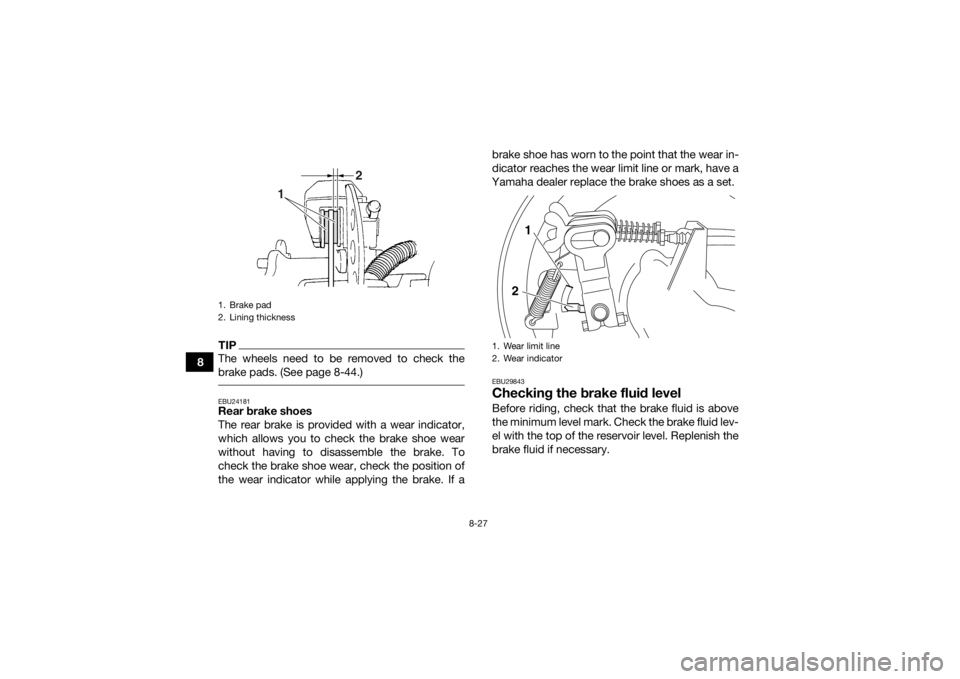
8-27
8
TIPThe wheels need to be removed to check the
brake pads. (See page 8-44.) EBU24181Rear brake shoes
The rear brake is provided with a wear indicator,
which allows you to check the brake shoe wear
without having to disassemble the brake. To
check the brake shoe wear, check the position of
the wear indicator while applying the brake. If abrake shoe has worn to the point that the wear in-
dicator reaches the wear limit line or mark, have a
Yamaha dealer replace the brake shoes as a set.
EBU29843Checking the brake fluid levelBefore riding, check that the brake fluid is above
the minimum level mark. Check the brake fluid lev-
el with the top of the reservoir level. Replenish the
brake fluid if necessary.
1. Brake pad
2. Lining thickness
2
1
1. Wear limit line
2. Wear indicator
1
2
UB1463E0.book Page 27 Thursday, August 4, 2016 2:12 PM
Page 107 of 140
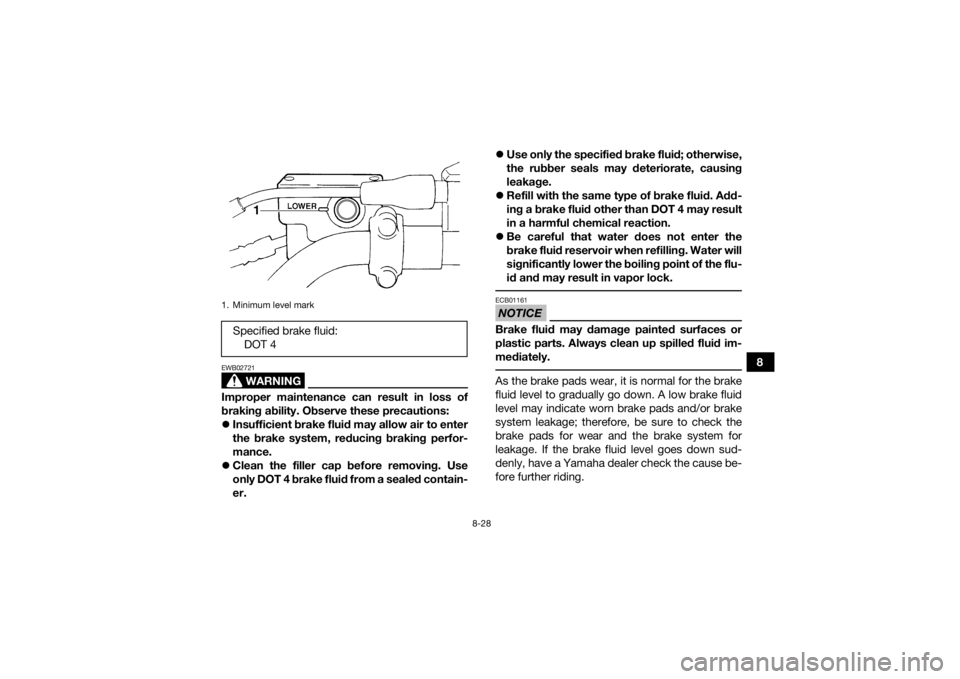
8-28
8
WARNING
EWB02721Improper maintenance can result in loss of
braking ability. Observe these precautions:
Insufficient brake fluid may allow air to enter
the brake system, reducing braking perfor-
mance.
Clean the filler cap before removing. Use
only DOT 4 brake fluid from a sealed contain-
er.
Use only the specified brake fluid; otherwise,
the rubber seals may deteriorate, causing
leakage.
Refill with the same type of brake fluid. Add-
ing a brake fluid other than DOT 4 may result
in a harmful chemical reaction.
Be careful that water does not enter the
brake fluid reservoir when refilling. Water will
significantly lower the boiling point of the flu-
id and may result in vapor lock.
NOTICEECB01161Brake fluid may damage painted surfaces or
plastic parts. Always clean up spilled fluid im-
mediately. As the brake pads wear, it is normal for the brake
fluid level to gradually go down. A low brake fluid
level may indicate worn brake pads and/or brake
system leakage; therefore, be sure to check the
brake pads for wear and the brake system for
leakage. If the brake fluid level goes down sud-
denly, have a Yamaha dealer check the cause be-
fore further riding.
1. Minimum level markSpecified brake fluid:
DOT 4
1
UB1463E0.book Page 28 Thursday, August 4, 2016 2:12 PM
Page 108 of 140
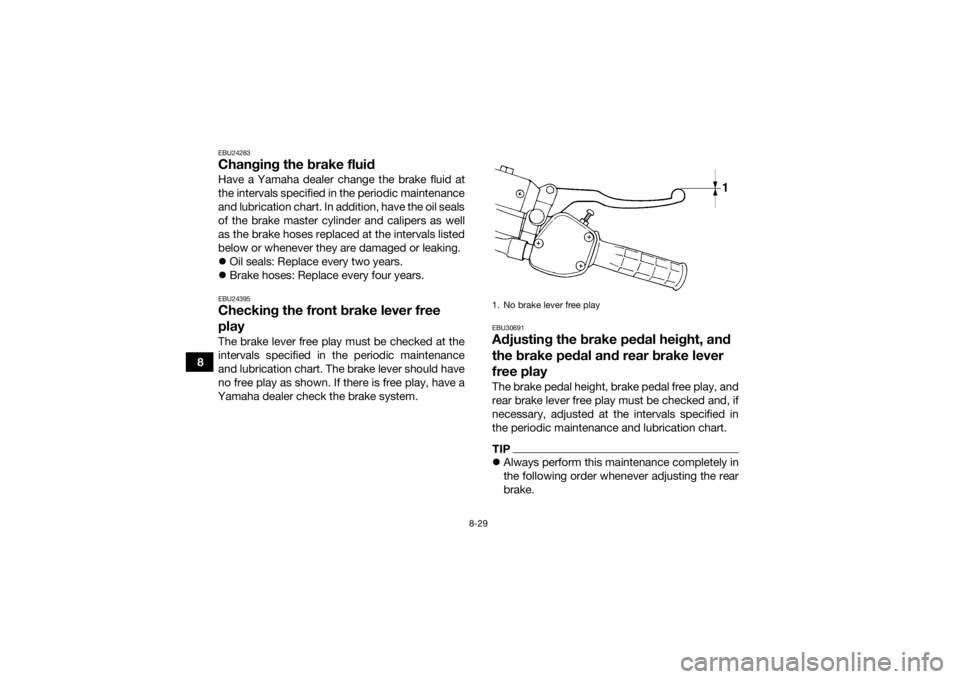
8-29
8
EBU24283Changing the brake fluidHave a Yamaha dealer change the brake fluid at
the intervals specified in the periodic maintenance
and lubrication chart. In addition, have the oil seals
of the brake master cylinder and calipers as well
as the brake hoses replaced at the intervals listed
below or whenever they are damaged or leaking.
Oil seals: Replace every two years.
Brake hoses: Replace every four years.EBU24395Checking the front brake lever free
playThe brake lever free play must be checked at the
intervals specified in the periodic maintenance
and lubrication chart. The brake lever should have
no free play as shown. If there is free play, have a
Yamaha dealer check the brake system.
EBU30691Adjusting the brake pedal height, and
the brake pedal and rear brake lever
free playThe brake pedal height, brake pedal free play, and
rear brake lever free play must be checked and, if
necessary, adjusted at the intervals specified in
the periodic maintenance and lubrication chart.TIP Always perform this maintenance completely in
the following order whenever adjusting the rear
brake.1. No brake lever free play
UB1463E0.book Page 29 Thursday, August 4, 2016 2:12 PM
Page 109 of 140
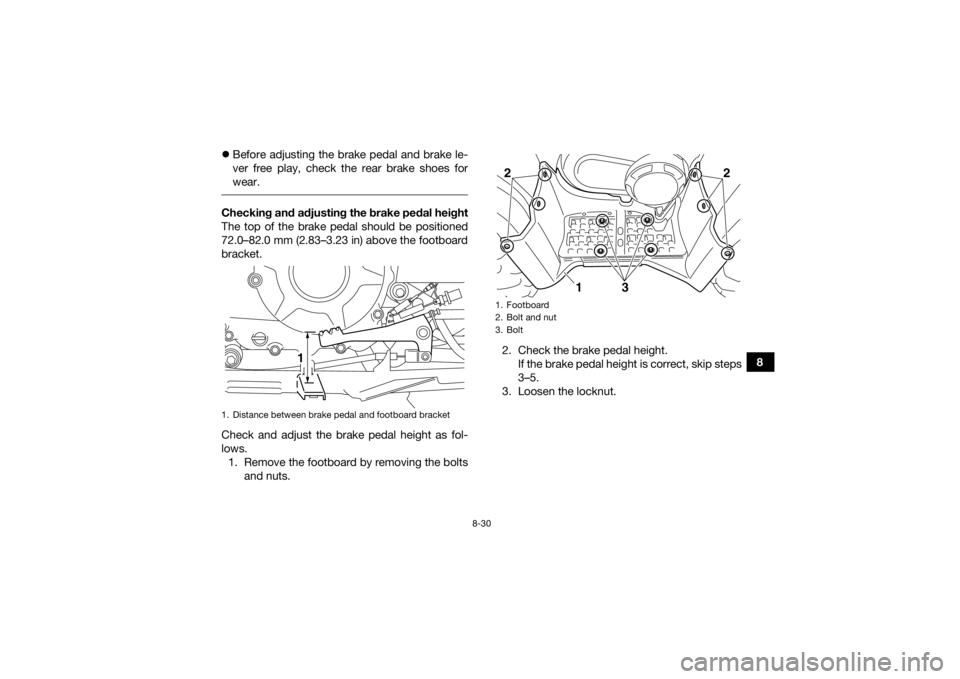
8-30
8
Before adjusting the brake pedal and brake le-
ver free play, check the rear brake shoes for
wear.
Checking and adjusting the brake pedal height
The top of the brake pedal should be positioned
72.0–82.0 mm (2.83–3.23 in) above the footboard
bracket.
Check and adjust the brake pedal height as fol-
lows.
1. Remove the footboard by removing the bolts and nuts. 2. Check the brake pedal height.
If the brake pedal height is correct, skip steps
3–5.
3. Loosen the locknut.1. Distance between brake pe dal and footboard bracket
1
1. Footboard
2. Bolt and nut
3. Bolt22
31
UB1463E0.book Page 30 Thursday, August 4, 2016 2:12 PM
Page 110 of 140
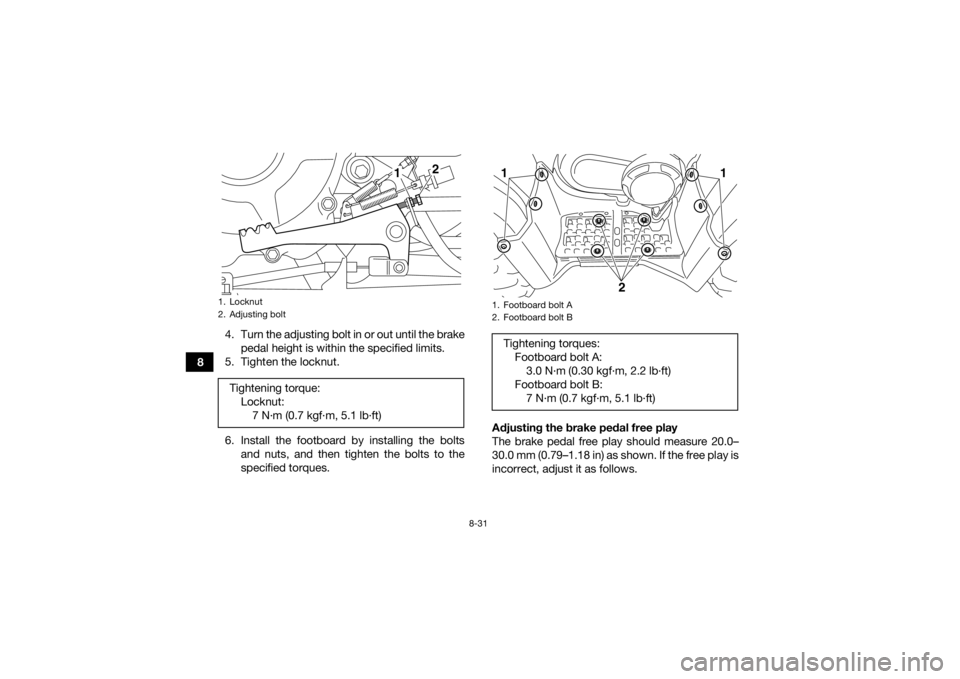
8-31
84. Turn the adjusting bolt in or out until the brake
pedal height is within the specified limits.
5. Tighten the locknut.
6. Install the footboard by installing the bolts and nuts, and then tighten the bolts to the
specified torques. Adjusting the brake pedal free play
The brake pedal free play should measure 20.0–
30.0 mm (0.79–1.18 in) as shown. If the free play is
incorrect, adjust it as follows.
1. Locknut
2. Adjusting boltTightening torque:
Locknut:7 N·m (0.7 kgf·m, 5.1 lb·ft)
1
2
1. Footboard bolt A
2. Footboard bolt BTightening torques:Footboard bolt A:3.0 N·m (0.30 kgf·m, 2.2 lb·ft)
Footboard bolt B: 7 N·m (0.7 kgf·m, 5.1 lb·ft)11
2
UB1463E0.book Page 31 Thursday, August 4, 2016 2:12 PM